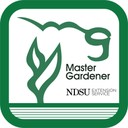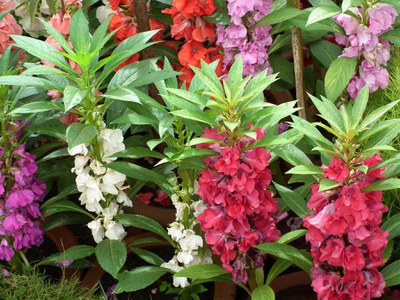Documents
A Forgotten Treasure
It’s always fun to grow something different in the garden. This year you may want to try a flower from the past. Balsam is a charming, heirloom flower with delicate blooms. Bees love balsam and so will you!
Balsam (Impatiens balsamina) was treasured by gardeners in the early 1900s but seems to have been forgotten. You won’t find balsam plants at most garden centers this spring when you look among the marigolds, petunias and impatiens.
Even if a garden center offered balsam, you probably would not give it a second look. When it is young, all you see is a single stem covered from top to bottom with pointy leaves. There are no flowers to draw your attention. Perhaps its inconspicuous appearance as a young plant is why few gardeners have discovered balsam.
Balsam is an easy to grow annual. It adapts well to both sunny and partially shaded conditions. Balsam grows especially well in sunny sites that are out of the harsh afternoon sun.
Balsam may be planted in containers or in garden beds. Seeds may be started indoors or directly sown in the garden.
The plants are sturdy, upright and narrow, growing about 12 to 36 inches tall. Blooms come in shades of pink, red, white and light purple.
The flowers may be a little hard to see as they are nestled between the leaves along the stem. Some gardeners pick off a few of the leaves to reveal more of the flowers, but I prefer the natural look of balsam. Bees and hummingbirds have no problems seeing the flowers. They love balsam.
We tested two varieties of balsam, ‘Camellia-Flower Mix’ and ‘Bush Mix’, in the 2020 North Dakota Home Garden Variety Trials. Most of these gardeners had never heard of balsam before. Each variety received high scores and enthusiastic recommendations from gardeners. Comments included:
“This is my first-time growing balsam and I loved it! It was loaded with bees and hummingbirds! I will be adding this flower to my pollinator garden next year! … Both varieties were very healthy and bloomed like crazy!”
“Both varieties grew extremely well and were an amazing addition to the garden … Both made a very impressive floral display both in garden and as cut flowers. The absolute best part—the bees loved both varieties.”
“Both varieties were pretty. It made me think I was vacationing in Hawaii. This was my first try at planting balsam! It was fun planting something different!”
“I had never grown balsam and didn’t know what to expect. These plants performed beautifully. … None of the plants developed disease and they bushed out nicely and bloomed for a long period. Both had a nice variety of colors. I’m glad I tried balsam and would grow either variety again.”
“I had never heard of this flower. Very hardy, pretty flower. … They were the best flowers I had of all my tests.”
“Balsam was a hardy plant that was able to stand the winds in our area. … They were great for fillers in flowerpots and adding interest in the garden.”
“It had strong stems for a vase arrangement. I had not grown balsam before but will add it in the middle of my plantings.”
“This was my first experience with balsam. Despite the heat and dry summer, both varieties did very well. They were very colorful, 3-foot plants. The seed pods were interesting, and I saved a few to plant next spring. Balsam is a lovely addition to any garden!”
These gardeners were surprised and enchanted by balsam. You may wish to give this heirloom a try yourself. Both you and the bees will be delighted.
Written by Tom Kalb, NDSU Extension Horticulturist. Photo courtesy of Rameshng.
Bee Friendly
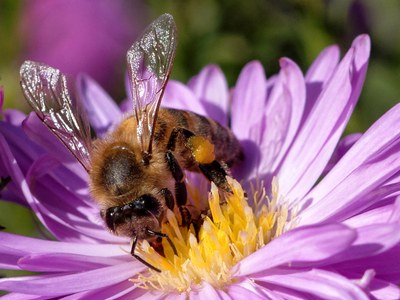 The undisturbed prairies of North Dakota were once a haven for bees, but the landscape of our state is changing. The oil boom, increased pesticide use and an onslaught of mites are threatening bees. We can no longer take these insects for granted.
The undisturbed prairies of North Dakota were once a haven for bees, but the landscape of our state is changing. The oil boom, increased pesticide use and an onslaught of mites are threatening bees. We can no longer take these insects for granted.
Bees are vital for a productive garden. We need them for cucumbers, melons and squash. We need them for berries, apples, cherries and other popular fruits.
We can take steps to make our landscapes bee friendly. Bees are just like every other creature on earth. They need food, water and a safe shelter.
Bees need food. Grow lots of different flowers. Bees will forage on flowers from the first crocus in spring until the last aster in fall (photo). Native plants are especially well suited for attracting native bees and other pollinators.
Preferred perennials include beebalm, blazing star, blanketflower, goldenrod and aster. Useful annuals include sunflower, salvia and snapdragon. Herbs such as borage, basil and chives are welcome.
Bees need water. Bees will drink from rims of bird baths. A piece of wood in the bath can serve as a landing platform for bees. You can make a bee bath by placing a shallow plate on the ground, lining it with rocks.
Bees need a safe shelter. Bees generally do not need help in constructing nests, but bee houses are easy to construct. Many bees nest in soil so allow some bare patches in the garden.
Avoid insecticides. Dust and wettable powder formulations are especially dangerous because they collect in the hair of bees. Insecticides that are relatively safe for bees include Bacillus thuringiensis, neem and horticultural oils. Chemicals should be applied in the evening when bees are not active. Avoid products with long residual activity such as soil drenches of imidacloprid.
The Xerces Society is a good source of information on attracting pollinators. For more information, read Bee-utiful Landscapes: Building a Pollinator Garden.
Written by Tom Kalb, Extension Horticulturist, North Dakota State University. Information was taken from an article published in the NDSU Yard & Garden Report, July 31, 2015. The photo was made available under a Creative Commons license specified by the photographer: Michael Frank Franz.
Restore the monarchy
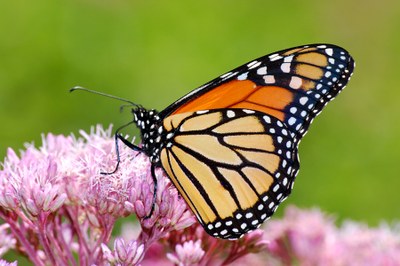 Monarchs in North Dakota are happy today. They are feeding and breeding in our flower-filled prairies and gardens.
Monarchs in North Dakota are happy today. They are feeding and breeding in our flower-filled prairies and gardens.
Everyone loves monarchs for their bright orange wings and gentle habits. I invite you to take a closer look at this insect and you will find a true marvel of nature:
No other insect on earth can match the migration of the monarch. In late August, the monarchs of North Dakota begin a round-trip pilgrimage to Mexico covering over 5,000 miles. They will soar in the skies like hawks, gliding 25 miles or more a day. Remarkably, they will arrive to the same villages and even the same trees their great-grandparents visited the year before.
Did you know monarchs can scare away predators that are over 100 times their size? Imagine that! They gain these powers by eating and storing toxins from milkweed in their bodies. Many birds, lizards and other predators have evolved to avoid monarchs due to these toxins.
Monarchs are amazing creatures but also very fragile. Their populations have declined by 80% over the last 20 years. This is due to many factors including the loss of overwintering sites in Mexico. In the USA they have lost breeding habitats due to agricultural expansion. The development of herbicide-tolerant crops has led to major increases in herbicide use and eliminated milkweed patches growing in pockets of farm fields where it once grew abundantly.
We can restore populations of monarchs by growing ornamental milkweeds (Asclepias spp.) in our gardens. Swamp milkweed is shown above. Monarchs cannot survive without milkweed. They lay eggs in milkweed, eat milkweed as caterpillars for its nourishment and protective toxins, and consume milkweed nectar as butterflies.
Besides growing a few milkweeds, try to reduce the unnecessary use of poisonous insecticides. These chemicals threaten monarchs, pollinators and other beneficial insects.
Written by Tom Kalb, Extension Horticulturist, North Dakota State University. The photo was made available under a Creative Commons license specified by the photographer: Brad Smith. This article was originally published in the NDSU Yard & Garden Report. Source used for this article: Oberhauser, K. 2015. University of Minnesota Monarch Lab. Univ. of Minnesota: Twin Cities.
Perfect perennials
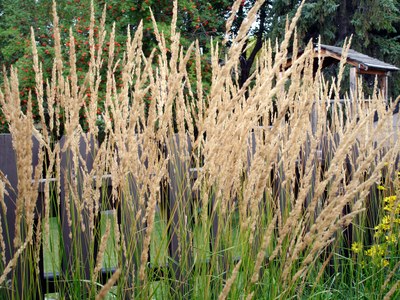 North Dakota is a land of prairie grasses. Our soils and climate are made for growing grasses. That’s one reason why ornamental grasses are perfect for us. They are loaded with other great features too:
North Dakota is a land of prairie grasses. Our soils and climate are made for growing grasses. That’s one reason why ornamental grasses are perfect for us. They are loaded with other great features too:
Ornamental grasses are easy to maintain. They rarely need watering or fertilizing. Just cut the plants back every spring—that’s it!
They have almost no pest problems. Insects or diseases rarely bother ornamental grasses. Believe it or not, deer don’t like them! That’s too good to be true!
They grow fast. Many grasses will grow up to their mature height, even up to 8 feet, within two growing seasons.
They look good all year. You’ll enjoy a changing canvas of color from the emergence of tender grass in the spring to a display of roughened textures and brilliant colors in fall and winter. As a bonus, their seed heads attract lively and colorful birds to our yards.
‘Karl Foerster’ feather reed grass is one of the most popular perennials grown today (see photo). Plants grow 5 feet tall and provide a striking vertical dimension to flower beds. Its carefree habit has made it a staple in low-maintenance landscapes. Other popular feather reed grasses include ‘Overdam’ and ‘Avalanche’, each with eye-catching variegated leaves.
‘Northwind’ switchgrass was awarded the prestigious Perennial Plant of the Year award in 2014 (‘Karl Foerster’ won in 2001). ‘Northwind’ has olive-green foliage and a sturdy, upright habit. Another showy switchgrass is ‘Shenandoah’, noted for its stunning burgundy leaves and plumes in autumn.
Written by Tom Kalb, Extension Horticulturist, North Dakota State University. The photo was made available under a Creative Commons license specified by the photographer: daryl_mitchell. More photos are available in the NDSU Yard & Garden Report.
Gift ideas for gardeners
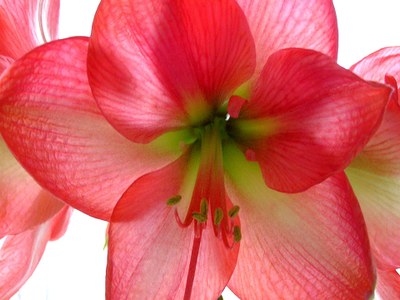 The holidays are here and so are the busiest shopping days of the year! Gardening is America’s #1 hobby and you can bring happiness to others by giving gardening presents.
The holidays are here and so are the busiest shopping days of the year! Gardening is America’s #1 hobby and you can bring happiness to others by giving gardening presents.
Amaryllis is a great holiday gift. It is showy and one of the easiest plants to grow. A quality bulb company can offer extra large bulbs that will bloom this year and in future years too. Always remember: the bigger the bulb, the better.
The following is a brief description of more gift ideas:
Lightweight gardening hoses are getting popular. Good pruning tools are always appreciated. A pocket knife is a handy gift. Solar-powered gardening pots are popular—they glow at night!
A new shovel, spading fork or hoe will be appreciated by a true gardener. A garden cart can help your friend move plants and tools around their yard.
Nitrile garden gloves are very popular. Hand scrubbing lotions will clean and moisturize our hands (the most important gardening tools).
We all need to eat more veggies. A juicing machine can help us to get all the servings we need for a healthy diet. A dehydrator can convert our garden produce into nutritious snacks.
Thermometers, soil thermometers and rain gauges provide valuable information to a gardener.
Gnomes and other garden statuary are risky gifts, but sometimes these gifts bring the biggest smiles!
When all else fails, a gift certificate to a local garden center or a gardening catalog will put a smile on your friend’s face.
Happy holidays!
Written by Tom Kalb, Extension Horticulturist, North Dakota State University. This article is an excerpt of a story published in the NDSU Yard & Garden Report, November 15, 2014. The photo was made available under a Creative Commons license specified by the photographer: Liz West.


